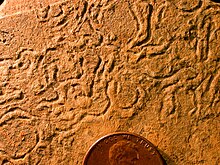
The Droser-Bottjer ichnofabric index is a method used to quantify the degree of bioturbation in a sedimentary rock. It involves grading the amount of trace fossil activity on a scale of 1–6; a value of 1 indicates that bioturbation is entirely absent, whereas the highest grade would involve a bedding plane containing over 60% trace fossil cover.
Application
Ichnofabric index can be applied in either a vertical or horizontal aspect. The vertical component provides an indication of the interplay between physical and chemical aspects of the environment and the degree of biological activity. The vertical ichnofossil index is harder to measure; it involves quantifying the amount of disturbance to the original sedimentary fabric.
References
- Barras, C. G.; Twitchett, R. J. (2007). "Response of the marine infauna to Triassic–Jurassic environmental change: Ichnological data from southern England". Palaeogeography, Palaeoclimatology, Palaeoecology. 244 (1–4): 223–241. Bibcode:2007PPP...244..223B. doi:10.1016/j.palaeo.2006.06.040.
- Miller, M. F.; Smail, S. E. (1 August 1997). "A Semiquantitative Field Method for Evaluating Bioturbation on Bedding Planes". PALAIOS. 12 (4): 391–396. Bibcode:1997Palai..12..391M. doi:10.2307/3515338. ISSN 0883-1351. JSTOR 3515338.
- Droser, M.L.; Bottjer, D.J. (1986). "A semiquantitative field classification of ichnofabric". Journal of Sedimentary Research. 56 (4): 558–559. Bibcode:1986JSedR..56..558D. doi:10.1306/212f89c2-2b24-11d7-8648000102c1865d.
This trace fossil-related article is a stub. You can help Misplaced Pages by expanding it. |